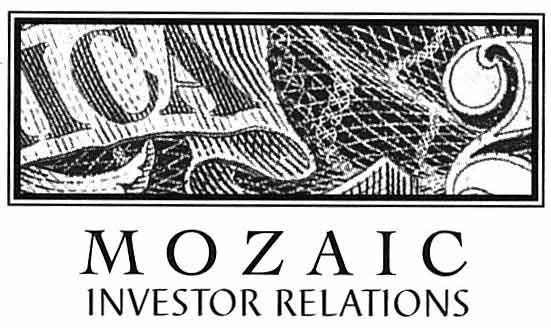15 May, 2019
By Mary Jane Maytum
, Business First On the heels of the Enron and Worldcom debacles, with the market spiraling down, many investors are learning that what a company says or appears to say can be a far cry from the truth. But for those adventurers who wish to invest in company stocks or mutual funds of their own choosing, words can still reveal some realities if one is willing to take the time to look closely, according to local investors. "It used to be you could open an annual report and look at the auditor's letter. If there was anything wrong, the auditor would tell you. Today, you really have to do your homework," explained Terry McWilliams, president and CEO of Mozaic Investor Relations in Louisville. McWilliams, whose firm helps companies write those reports, said that the self-investor should keep in mind that a company should be viewed as a whole from its balance sheets to its leadership to its capital investments and not by words alone. "I don't think it's a word or phrase as much as it's the totality," McWilliams said. "And I think it is a gut feeling whether or not you think someone's pulling the wool over your eyes." Other investors also warned that it is wise to keep a steady hand on your portfolio and a clear head while searching for those good investments. " 'Discipline' is the word in our business to hold onto your stock even after two and a half years of low performance, to maintain your portfolio and remain diversified," said Elizabeth Stegner Peabody, president of Stegner Investment Associates Inc. Peabody noted that "diversification" is still the wisest decision an investor can make. "Even if it's a great stock, you shouldn't be more invested than 5 percent (of your portfolio). Be a bull or a bear, but don't be a pig. Don't be so enamored with a stock that it weights your portfolio." Gross, net and the bottom line But what words or terminology in a company's report might make an investor step back or go forward? Quin Bernhardt, senior financial adviser at Highland Financial Management on Bardstown Road, said that a look at earnings is a good place to begin. "I think the main thing an investor needs to look for is price per earnings and earnings per share," Bernhardt said. "As well as getting a general feel from recent news about the company." If phrases such as "price per earnings" (P/E ratio) or "earnings per share" are unfamiliar, don't fret. There are a variety of financial Web sites offering insight into terminology used by investors, according to local brokers and advisers. For example, Investorwords.com says that it offers "the biggest, best investing glossary on the Web," with a host of clear definitions and examples. One investment expert noted, however, that even the numbers can be misleading. "Cash flow analysis, P/E ratios are only as good as what goes into them," said Earl G. Winebrenner III, president of Winebrenner Capital Partners LLC in Louisville. "Accounting is an opinion, but cash is a fact. You should beware of companies that are flaunting up their earnings numbers with noncash. "For example, Enron showed gains, but they were gains only on paper. I don't care how you treat your depreciation or amortization," Winebrenner said. "You want to know the cash they started with and the cash they ended the year with." Winebrenner also recommended that while looking at a company's balance sheet, the investor should determine how much of the company's book value is goodwill, or intangible assets, such as a strong brand name. Goodwill is something that an acquiring company records as the amount paid over and above the net tangible assets of the company. "Go to the shareholders equity and look back under assets to see how much was goodwill. For example, Coca-Cola is a good thing, they have a lot of goodwill," he said. "But if a company has paid twice what an acquisition was worth, half that overpayment is going to come home to roost." Debt ratios are another cause for scrutiny. "Rules of thumb are debt loads," McWilliams said, who recommended visiting the Yahoo! Finance Web site for a list of primary ratios. "But keep in mind that a good ratio for one industry can be terrible for another," he added. "For instance, a utility company may have a large debt load because they're financing power plants over a long period of time. That's not a bad thing, but in another sector it is." Bernhardt agreed that a company's debt can be cause for concern. "Does the company have a positive cash flow? What is their leverage or indebtedness? You certainly need to look at their return on equity. Are they up to their eyeballs in debt?" Bernhardt asked. Winebrenner said a recent example of a company carrying a heavy debt load was Kindred Healthcare Inc., formerly Vencor Inc., a Louisville-based long-term acute-care hospital and nursing home company. "Vencor had a tremendous amount of debt, particularly after buying Hillhaven," Winebrenner said, regarding the September 1995 purchase of the company, which owned more than 300 nursing homes nationwide. "Their debt to equity ratio was very high," he said. "Those are the ones that have issues jumping out at you." E.J. Gary, president of First Commonwealth Capital Management Inc. in Louisville, said that a company's consistency in dividend payments also can be a factor worth examining when deciding whether to purchase stock. "Do the companies consistently pay a dividend? And increasingly people are looking at dividend income," Gary said. "In the past, people were just interested in growth. Now they're willing to take a dividend and pay taxes on it. Someone once told me that 57 percent of the worth of NYSE stocks were actually due to dividends that were reinvested." 'Dear Shareholder: It was a bad year ' While taking into account the various earnings, assets and debts of a company, McWilliams said a simple reading of the CEO's letter in an annual report also can reveal a lot about the character of a company, which may indicate its worthiness as an investment. "If you read the annual reports and all their documentation and still don't understand, run away from it," McWilliams said. A wise investor will take time to research the quality of a company's management, including a company's CEO, McWilliams said, asking the questions, "Does it have integrity; is it ethical; do they have a long career in the field?" In addition, annual reports should provide the reader an unusual amount of detail, he said. "It should be like opening festering sores," he said. "If you see them saying 'our cash flow expanded six times last year' and you look at the bottom line and there's a loss, look out." Another item to look for are "letters that are not in layman's terms but rather use obtuse industry terms that's a red flag." Other red flags are charts or graphs that fail to give a step-by-step account of the year or that cannot be easily read or understood, according to McWilliams. Honesty should be apparent. "In the long run it's best to be as transparent and open as possible, he said. "I had a client that had a horrible year, and I recommended that they say that in their annual report: 'it was a bad year.' And they did in the first paragraph of their shareholders' letter," McWilliams explained. For details on management, Winebrenner said he relies on the U.S. Securities and Exchange Commission Web site, saying "everything else is someone's opinion." "There's a lot of information there annual and quarterly reports," he said. "You can review management discussion, where management is supposed to discuss the positive and negative about the past and going forward. "Now if you're a crook, you're a crook," Winebrenner said. But some things may come out in the transaction section, such as any issues like lawsuits or interesting arrangements an investor might want to be aware of." Arrangements such as "blatant ties" between board members and management for example, relatives of company management serving on the board are definite red flags, McWilliams said. "Look for truly independent board members. Research them the same way you would management. The SEC requires 'nondependent' management. In the proxy, you can find a listing of transactions between management and directors," McWilliams said. The CEO's letter is one item that McWilliams said he "puts a lot of stock in." "I want to look at the numbers obviously," he said. "But I also want to look at what the CEO is telling you. He's going to have the decisions. He's going to have the leadership plan. I want to know: What is his map, and how is he going to get there?" Winebrenner also noted that frequent change of management could signal a red flag. When creditors speak, listen McWilliams and Winebrenner also suggest two other areas to research: a company's bond rating and senior notes. "Look and see what the bond rating agencies are doing." McWilliams said. "Moody's (Investors Service) rates bonds, but Moody's (also) looks at what the whole company is doing to see if they are stable. If it's a strong company, then they get a good bond rating." Winebrenner said a company's senior creditor or bank also can give an investor a good indication of whether the company is solvent. "If I have a company that may be in trouble, I go and see where the bonds are trading," Winebrenner said. "The stock market may be emotional, but a senior creditor is not. If they're backing out and turning everything to cash, there's trouble." In addition, Winebrenner said, "what the bank thinks of their prospects of getting paid is a good indicator." This also bears out by observing trading conditions, he said. In the face of such a magnitude of available information, novice investors easily can feel overwhelmed. Web sites, groups aid investors McWilliams suggested either seeking out an independent analyst "that doesn't do investments also" or using the resources of the National Association of Investment Clubs (http://better-investing.org). The NAIC has a local chapter and offers publications, software and groups to assist individuals with the process of analyzing companies for investing. Some people also form their own investment clubs. Matt Westfall, an attorney at Talbott & Talbott PLLC, and a few college buddies formed their own investment/social club in 1998. With a small initial contribution from each member and small monthly contributions, the club members have been gaining some firsthand market experience. "One of the first red flags in my limited experience would be 'nonrecurring expenses.' If a company says that the expense is special to this situation and that we won't see it again, that's a red flag because there's been a lot of creative bookkeeping going on that has mislabeled expenses and income," Westfall said.
On a whole, the group has given its members an opportunity to "play the market." But Westfall said he and his friends have begun to wise up after the fall of Enron and Worldcom, two companies in which they invested, though not heavily. "One of the things we try to stick with is companies we know, that are proven in the stock market GE, Procter & Gamble, some big pharmaceutical companies. We would be much more interested in a company that has a brick and mortar building, a real asset, that would hold up. And right now we take a very wary look at tech. With stocks going from $80 to $6 (per share), we probably won't be interested in tech until we've hit a bottom in the market," Westfall said. Members of the club also have realized a little more homework can go a long way. "One thing we have learned is that we need to do a whole lot more research and in-depth analysis and ask questions like, 'Why do we need to invest in another tech company, just because this expert or so-and-so's brother-in-law who's a broker says it's great?' " he said. Mary Jane Maytum is a free-lance writer for Business First. This story originally appeared in Louisville Business First.





